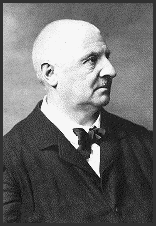 (born
Ansfelden, 4 September 1824; died Vienna, 11 October 1896).
(born
Ansfelden, 4 September 1824; died Vienna, 11 October 1896).
He was the son of a village schoolmaster and organist, with whom he first studied and for whom he could deputize when he was ten. His father died in 1837 and he was sent at 13 as a chorister to the St. Florian monastery where he could study organ, violin and theory. He became a schoolmaster-organist, holding village posts, but in 1845 returned to teach at St. Florian, becoming organist there in 1851. During these years he had written masses and other sacred works. In 1855 he undertook a counterpoint course in Vienna with the leading theorist, Simon Sechter; the same year he was appointed organist at Linz Cathedral. He continued his studies almost to the age of 40, but more crucial was his contact, in 1863, with Wagner's music - first Tannhäuser, then Tristan und Isolde; these pointed to new directions for him, as the Masses in d Minor, e Minor and f Minor, and Symphony no.1, all written in 1864-8, show.
In 1868, after Sechter's death, he was offered the post of theory teacher at the Vienna Conservatory, which he hesitantly accepted. In the ensuing years he travelled to Paris and London as an organ virtuoso and improviser. In Vienna, he concentrated on writing symphonies; but the Vienna Philharmonic Orchestra rejected Sym. 1 as 'wild', Sym. 2 as 'nonsense' and 'unplayable' and Sym. 3 as 'unperformable'. When Sym. 3 was given, it was a fiasco. Sym. 4 was successfully played, but Sym. 5 had to wait 18 years for a performance and some of Sym. 6 was never played in Bruckner's lifetime. He was criticized for his Wagnerian leanings during the bitter Brahms-Wagner rivalries. His friends urged him to make cuts in his scores (or made them for him); his lack of self-confidence led to acquiescence and to the formal distortion of the works as a result. Late in his life he revised several of his earlier works to meet such criticisms.
Bruckner taught at a teacher-training college, 180-74. and at Vienna University - after initial opposition - from 1875. Only in the 1880s did he enjoy real success, in particular with Symphony no.7; his music began to be performed in Germany and elsewhere, and he received many honours as well as grants from patrons and the Austrian government. Even in his last years, he was asked to rewrite Symphony no.8, and when he died in 1896 Sym. 9 remained unfinished.
Bruckner was a deeply devout man, and it is not by chance that his symphonies have been compared to cathedrals in their scale and their grandeur and in their aspiration to the sublime. The principal influences behind them are Beethoven and Wagner. Beethoven's Ninth provides the basic model for their scale and shape, and also for their mysterious openings, fading in from silence. Wagner too influenced their scale and certain aspects of their orchestration, such as the use of heavy brass (from Sym. 7 Bruckner wrote for four Wagner tubas) and the use of intense, sustained string cantabile for depth of expression. His musical forms are individual his vast sonata-type structures often have three rather than two main tonal areas, and he tends to present substantial sections in isolation punctuated by pregnant silences. Huge climaxes are attained by remorseless reiterations of motifs, or, in the Adagios, by the persistent use of swirling figural patterns in the violins against which a huge orchestral tutti is inexorably built up, often with ascending phrases and enriching harmonies. Secondary themes often have a chorale-like character, sometimes counterpointed with music in dance rhythms. Slow movements are often planned (as in Beethoven's Ninth) around the alternation of two broad themes. Scherzos are in 3/4, often with the kind of elemental drive of that in Beethoven's Ninth; they carry hints of Austrian peasant dances, and some of the trios show läandler-like characteristics. From Sym. 3 onwards, Bruckner's symphonies each end with a restatement of the work's opening theme.
Because of their textual complications, Bruckner's symphonies have mostly been published in two editions: the Sämtliche Werke series (ed. R. Haas and others, in grey covers) usually give the work as first written, the Gesamtausgabe (ed. L. Nowak and others, in blue covers) the revised and cut versions.